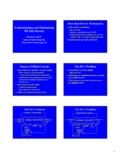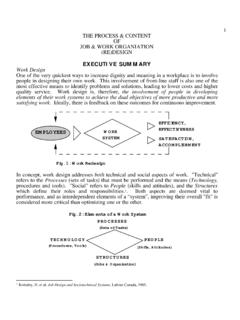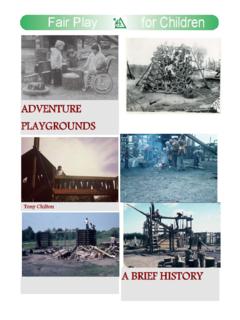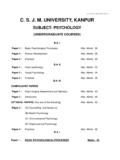Transcription of POWERS and SONS LLC
1 ~ Customer Liaison Office ~ 1111 Bellevue St Detroit, MI 48207-3647 Phone (734) 261-9642 Fax (313) 579-2379 Se Habla Steering? Many of us who have been in the business for a number of years take too much for granted in our field of expertise. I walked into the wrong meeting once. (I m sure I was in the right place, the meeting was wrong.) I sat through a design review of seat mechanisms. I felt like a fish on a bicycle. I didn t know the terms. I couldn t follow the presentation. I didn t have a basic understanding of the system. If I ever went to work for Lear, I d be lost. With this in mind we thought about the newcomer to steering linkage systems. It is in our best interest to get this person conversant in steering linkage as quickly as possible. We have prepared the following information to help someone unfamiliar with steering systems get a quick, broad overview of how steering linkage works, some terminology and some rough idea of the design guidelines.
2 We gathered this information from our internal design guide, industry papers and interviews with new employees to see what would be relevant. This information was compiled, to a large degree, by employees who were newcomers to POWERS and Sons LLC. Who better to determine what fresh eyes needed to see than someone with fresh eyes? Much of the information contained here may insult the intelligence of the old salt. This isn t written for you. Pass it along to someone who might benefit from it. To anyone with comments on how to make this a more effective tool, please call me. To anyone who wants to pick nits over details or gripe about anything here, write your own damn book. Gene Messenger Customer Liaison Manager By the way, copyright protection is being requested for the information attached. Please don t copy it without asking first. Better yet, give us a call and we will provide extra copies.
3 -Gene POWERS and SONS LLC ~ Customer Liaison Office ~ 1111 Bellevue St Detroit, MI 48207-3647 Phone (734) 261-9642 Fax (313) 579-2379 STEERING LINKAGE TYPES There are three basic types of steering linkage used in passenger cars and light trucks. These are Rack and Pinion, Parallel Linkages and Haltenberger Linkages. There are other variations on those designs described in this section, but these are the three fundamental types. Heavy truck and certain non-highway vehicles utilize significantly different types of steering linkage. Rack and Pinion Linkage As the driver turns the steering wheel, the shaft that runs from the steering wheel to a pinion gear (1) causes the pinion gear to turn. As the pinion gear turns it causes the rack (2) to move side to side. As the rack moves side to side it will push the tie rod ends (3) and the steering arms (4) in the desired direction thus turning the wheels.
4 Advantages of this system include precise geometry, a relatively low weight, and a relatively low cost. The main disadvantages or rack and pinion linkage are a relatively low carrying capacity and inflexibility when it comes to packaging and space within the car. ~ Customer Liaison Office ~ 1111 Bellevue St Detroit, MI 48207-3647 Phone (734) 261-9642 Fax (313) 579-2379 Parallel Linkage As the driver turns the steering wheel the shaft which runs from the steering wheel to a steering gear (1) rotates causing the pitman arm (2) to rotate. The pitman arm is connected to a center link (3), which will move side to side. This side to side motion will cause the tie rod end/sleeve assembly (4) and steering arms (5) to move thus turning the wheels in appropriate direction. The idler arm (6) connects the steering linkage to the frame and keeps everything parallel and aligned properly.
5 Advantages of this system include precise geometry, high load carry capability, and package friendly; meaning it can be designed easily to work around obstacles such as an oil pan. The main disadvantage of parallel linkage is a relatively higher weight and cost. ~ Customer Liaison Office ~ 1111 Bellevue St Detroit, MI 48207-3647 Phone (734) 261-9642 Fax (313) 579-2379 Haltenberger Linkage As the driver turns the steering wheel the shaft which runs from the steering wheel to a steering gear (1) rotates causing the pitman arm (2) to rotate. The pitman arm is connected to a drag link (3), which will move side to side. This side to side motion (or dragging) will cause the tie rod end (4) and steering arms (5) to move thus turning the wheels in the appropriate direction. Advantages of this system include a high strength capability; it is less expensive than parallel linkage; and it is package friendly meaning it can be designed to fit around obstacles such as an oil pan.
6 The main disadvantage of Haltenberger linkage is that it does not provide for precise geometry. ~ Customer Liaison Office ~ 1111 Bellevue St Detroit, MI 48207-3647 Phone (734) 261-9642 Fax (313) 579-2379 STEERING DAMPER Some vehicles are prone to shimmy and/or wheel fight. Shimmy is a condition similar to resonance in the suspension and steering system. With minor road inputs, the road wheel can begin to shake at the wheel rotation frequency. It can continue to amplify in intensity without any additional road inputs. Speeding up or slowing down can improve or eliminate the condition. The causes of shimmy are many and include tire construction, suspension geometry, frame flex, excess compliance and system resonant frequency. Wheel fight is the condition where a road irregularity tries to twist the steering wheel out of the driver s hands. Both of these conditions are more prevalent in truck and off road vehicles.
7 In some vehicles it is necessary to include a damper on the steering linkage to combat shimmy and wheel fight. This damper is a shock absorber mounted between the steering linkage and a fixed member, typically the frame. This shock absorber is designed to have very little resistance during relatively slow, high travel conditions (such as steering cycles). It has maximum dampening resistance during high frequency inputs. It can combat shimmy (repetitive high frequency inputs) and wheel fight (single occurrence high frequency input). The schematic below shows a typical steering damper installation on a haltenberger linkage. The damper must be packaged to insure no interference conditions exist throughout the range of steering travel, jounce or rebound travel. The system must also be designed to insure there is no binding of the damper during steering travel. ~ Customer Liaison Office ~ 1111 Bellevue St Detroit, MI 48207-3647 Phone (734) 261-9642 Fax (313) 579-2379 Tie Rod End Ball Sizing Tie rod end ball sizing is a function of numerous factors.
8 All must be considered. Pull out strength requirements Bearing Material requirements Articulation requirements Lubrication requirements Benchmark Vehicles The minimum tie rod end ball diameter must meet all of the above criteria. Tie Rod End Ball Sizing Pull Out Strength Requirement In any ball joint, the shank of the ball stud passes through one side of the housing. The area of the housing where the stud extends through is referred to as the window. The path established by the ball stud during articulation defines this window. Full metal-to-metal jounce and rebound travel + 2 degrees (factor of safety) is used for articulation travel. Larger ball stud shank diameters (required for impact strength) generally require larger windows. The ball stud shank can be undercut near the ball to minimize the window requirement. Undercutting the ball stud is an added operation.
9 Undercutting the stud in a taper from the ball to the gage line does not reduce the strength of the stud as bending stresses decrease linearly as you approach the ball center. ~ Customer Liaison Office ~ 1111 Bellevue St Detroit, MI 48207-3647 Phone (734) 261-9642 Fax (313) 579-2379 Once the window is defined and the housing thickness is established, a stress analysis can be conducted. Load to be used for this analysis is the maximum impact load multiplied by the sine of the maximum articulation angle + 2 degrees. For non-ferrous bearings, the stress analysis assumes no bearing. Maximum stress on the housing is to be 50% of the yield strength of the housing material. For designs using ferrous bearings, the same loading analysis is conducted, using the metal bearing. For metal bearings maximum stress must be 50% of the housing or bearing material (whichever is lower). ~ Customer Liaison Office ~ 1111 Bellevue St Detroit, MI 48207-3647 Phone (734) 261-9642 Fax (313) 579-2379 Tie Rod End Ball Sizing Bearing Stresses The ball size must be large enough to insure the bearing is not overstressed.
10 Projected bearing-to-ball stud projected surface area is calculated. Bearing surface contact area must be sufficient to insure projected surface area does not produce stresses beyond the capabilities of the bearing material. ~ Customer Liaison Office ~ 1111 Bellevue St Detroit, MI 48207-3647 Phone (734) 261-9642 Fax (313) 579-2379 Ball Joint Sizing Based Upon Lubrication Requirements There are many considerations for the proper sizing of a ball used in tie rod end applications. One of these is the unit pressure exterted on the grease in the socket. This pressure typically should not the pressure carrying capacity of the lubricant selected. The unit pressure is the sum of the static pressure inherent in the joint and the dynamic pressure due to loading. This is calculated through the following steps. An example is shown in italics for a typical 22mm wedge bearing part.








